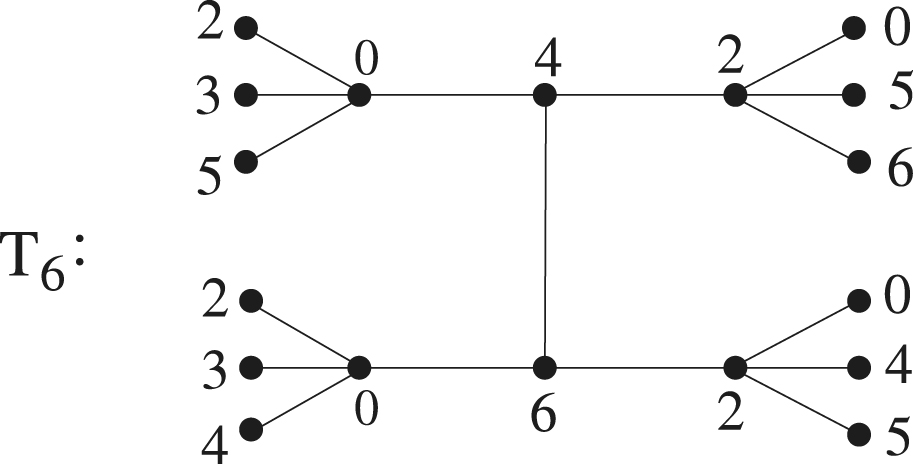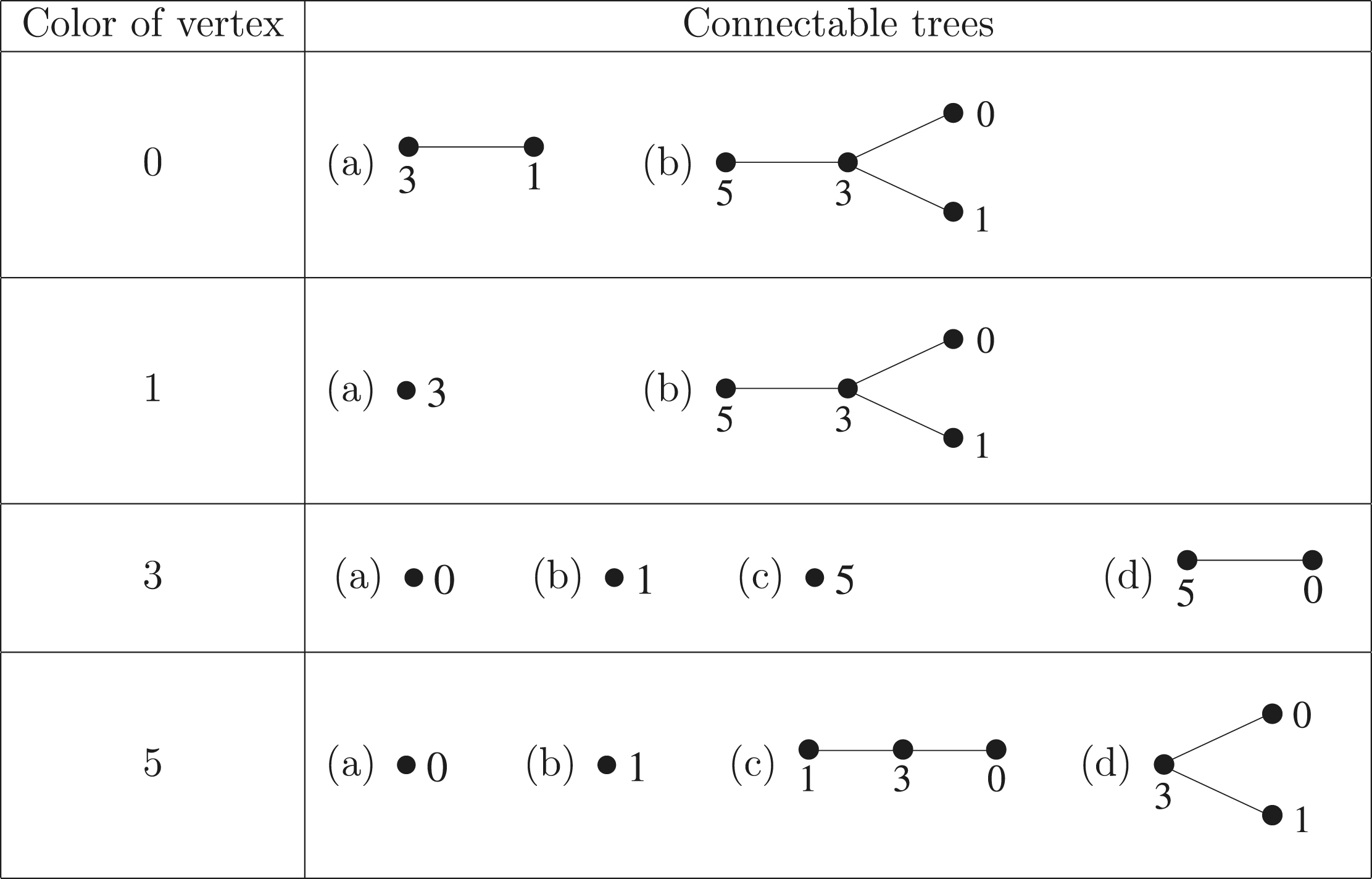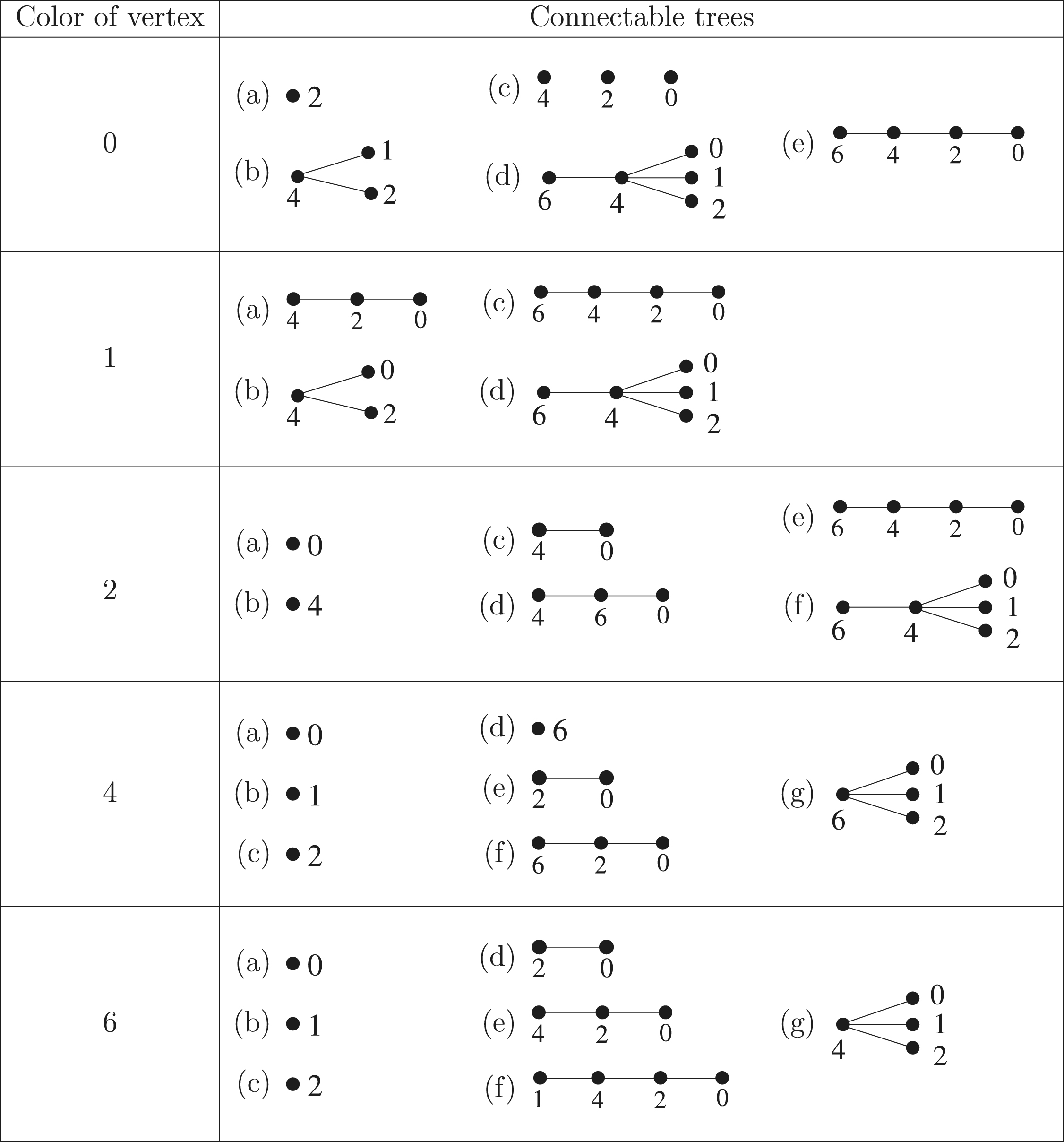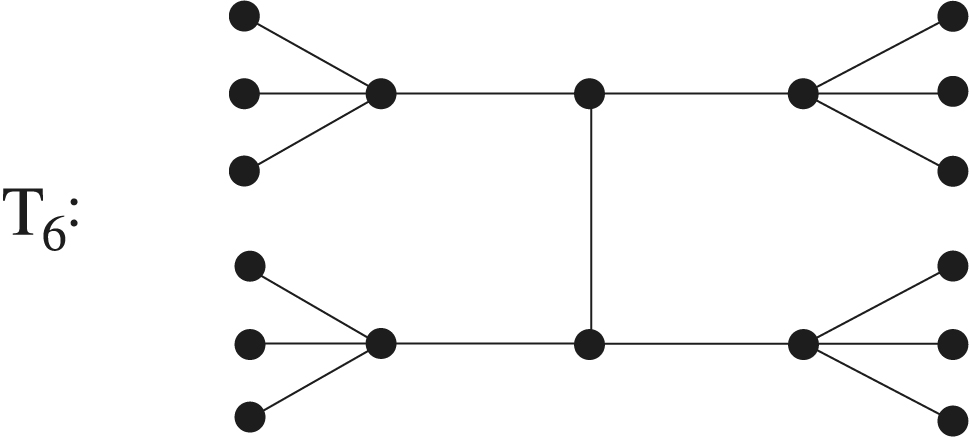 ?Mathematical formulae have been encoded as MathML and are displayed in this HTML version using MathJax in order to improve their display. Uncheck the box to turn MathJax off. This feature requires Javascript. Click on a formula to zoom.
?Mathematical formulae have been encoded as MathML and are displayed in this HTML version using MathJax in order to improve their display. Uncheck the box to turn MathJax off. This feature requires Javascript. Click on a formula to zoom.Abstract
An -coloring of a simple connected graph
is an assignment of non-negative integers to the vertices of
such that adjacent vertices color difference is at least two, and vertices that are at distance two from each other get different colors. The maximum color assigned in an
-coloring is called span of that coloring. The span of a graph
denoted by
is the smallest span taken over all
-colorings of
. A hole is an unused color within the range of colors used by the coloring. An
-coloring
is said to be irreducible if no other
-coloring can be produced by decreasing a color of
. The maximum number of holes of a graph
, denoted by
, is the maximum number of holes taken over all irreducible
-colorings with span
. Laskar and Eyabi (Christpher, 2009) conjectured that if
is a tree, then
if and only if
,
. We show that this conjecture does not hold by providing a counterexample. Also, we give some classes of trees with maximum number of holes two.
1 Introduction
The Channel assignment problem is the problem of assigning frequencies to transmitters without interference. One of the variations of Channel assignment problem is -coloring of graphs. An
-coloring of a graph
, introduced by Griggs and Yeh [Citation1] is an assignment
from the vertex set of
to
such that
if
, and
if
, where
denotes the distance between the vertices
and
. The span of
is the largest integer assigned by
. The
-span or span
of a graph
is the smallest span of
taken over all
-colorings of
. In the introductory paper, they have proved that
for
and they have shown that
is either
or
for any tree
with maximum degree
. We refer a tree is Type-I if
, otherwise Type-II. In a graph
with maximum degree
, we refer a vertex
as a major vertex if its degree is
, otherwise it is a minor vertex. A
-path segment is a path between two major vertices. Wang [Citation2] has proved that if a tree
does not contain
-path segments of length 1, 2 and 4, then
is Type-I. Zhai et al. [Citation3] improved the above condition as if
does not contains
-path segment of length 2 and 4, then
. Mandal and Panigrahi [Citation4] have found that
if
has at most one
-path segment of length either 2 or 4 and all other
-path segments are of length at least 7. Wood and Jacob [Citation5] have given a complete characterization of the
-span of trees up to twenty vertices. Fishburn et al. [Citation6] have introduced the concept of irreducibility of
-coloring. An
-coloring
of a graph
is said to be irreducible if there is no
-coloring
of
such that
for all vertices
in
and
for at least one vertex
of
. An integer
between 0 and the span of an
-coloring
is said to be a hole if there is no vertex
such that
. The maximum number of holes over all irreducible span colorings of a graph
is denoted by
. Laskar and Eyabi [Citation7] have determined the maximum number of holes for paths, cycles, stars and complete bipartite graphs as 2, 2, 1 and 1 respectively. Also, they showed that
for any Type-I tree
and
if
is Type-II tree. Further, they conjectured as below.
Conjecture 1.1
[Citation7] For any tree ,
if and only if
is a path
,
.
In this paper, we give a counterexample for Conjecture 1.1 by giving a two hole irreducible span coloring for a Type-II tree which is not a path. Also, we consider some Type-II trees given by Wood and Jacob [Citation5] and for each tree, we construct infinitely many Type-II trees with maximum number of holes two.
2 Counterexample
In this section, we give a counterexample to Conjecture 1.1. Wood and Jacob [Citation5] have proved that a tree with maximum degree
and containing a subtree
with four major vertices
and
of
such that
,
,
and
is Type-II. For this subtree
, we define an irreducible span coloring with two holes which disproves Conjecture 1.1. For the sake of completeness, we give the proof given by Wood and Jacob [Citation5] to show
is Type-II.
Theorem 2.1
[Citation5] A tree with maximum degree
and containing a subtree
as below, is Type-II.

Proof
Suppose is Type-I, that is
. Let
be a span coloring of
. In any span coloring of a Type-I tree, any major vertex receives either 0 or
. Without loss of generality, let
and
. If
and
, then there is no possibility for coloring the vertices between
and
. Suppose that
and
. Since
,
and
, the only possibility for coloring the vertices between
and
is
. which is not possible as
. Therefore
is Type-II and hence
.
The following example gives a counterexample for Conjecture 1.1.
Example 2.2
It is clear that the coloring of given in is an irreducible
-span coloring with two holes.
3 Some classes of Type-II trees with maximum number of holes two
Wood and Jacob [Citation5] have given some sufficient conditions for a tree to be Type-II. We consider some of their sufficient conditions as below.
Theorem 3.1
[Citation5] A tree with maximum degree
and containing any of the following subtrees is Type-II.
| 1. |
| ||||
| 2. |
| ||||
| 3. |
| ||||
| 4. |
| ||||
| 5. |
| ||||
Now, we show that ,
. Later, in this section, we construct some classes of Type-II trees from
,
with maximum number of holes two. In the following theorem, we prove that there is no irreducible
-span coloring with two holes for
,
.
Theorem 3.2
For the trees ,
,
.
Proof
First, we consider with the following labeling and prove
.
 Suppose that
Suppose that has an irreducible
-span coloring
with two holes
,
. Since 0, the span of
and any two consecutive colors cannot be holes, the possibilities for
are
,
and
. If
, then any major vertex receives only either 0 or 2. If
, then neighbors of
receives 2, 4 and 5. Since at least one of the pendant vertices
and
receives the color 4 or 5 which is reducible to 3,
. So,
,
and
must be 2. If
, then
and
must be 2 and 0 respectively (as
is either 4 or 5). With this partial coloring there is no possibility for coloring the path
(only two colors 4 and 5 are available). If
is either 4 or 5. Then
and
must be 0 and 2 respectively. Since either
or
receives 0, there is no possible coloring for either
or
. Therefore, there is no irreducible span coloring of
with holes 1 and 3.
If , then any major vertex receives only 0 or 5. If
, then one of the colors assigned to
or
reduces to 1. So,
,
and
must be 0. If
or
receives 5 then it reduces to a hole 4. Therefore
and
receive the colors 2 and 3, and
receives the color
. Since
and
or 3,
and
receive 0 and 5 respectively. With this partial coloring there is no possibility for coloring the path
(only two colors 2 and 3 are available). Therefore, there is no irreducible span coloring of
with 1 and 4 as holes.
If , then any major vertex receives only 3 or 5. If
and
is 0 or 1, then
and
. In this case color 5 received by
reduces to a hole 4. If
and
, then
and
must be 3 and 5 respectively. With this partial coloring the possibilities for coloring the path
are
and
. In both the cases, one of the pendant vertices
or
receives 3, which reduces to a hole 2. If
, then
must be
otherwise
or
receives 3 which reduces to a hole
. So,
and
must be 5 and 3 respectively. With this partial coloring the possibilities for coloring the path
are
and
. In both the cases, the color 5 reduces to a hole 4. Therefore
.
Now, we consider with labeling as below.

Suppose that has an irreducible
-span coloring
with two holes
,
. The possibilities for
are
,
and
. If
, then as in
,
,
and
must be 2. Since
is adjacent to
,
. With this partial coloring there is no possibility for coloring the path
. If
, then
,
and
must be 0. As
and
are adjacent,
receives
. With this partial coloring there is no possibility for coloring the path
. If
, then any major vertex receives only 3 or 5. If
and
, the possibilities for coloring the path
are
and
. In both the cases,
or
receives 3 which reduces to 2. If
and
, then the possibilities to color the path
are
and
. In both the cases, the color 5 reduces to a hole 4. Therefore, there is no irreducible
-span coloring for
with two holes.
Next, we consider along with the following labeling.

Suppose that has an irreducible
-span coloring
with two holes
,
. Then
is
or
or
. If
, then any major vertex receives only either 0 or 2. Since one of the vertices
or
must receive 0, a pendant vertex adjacent to it receives 4 or 5 which reduces to a hole 3. If
, then any major vertex receives only either 0 or 5. Since one of the vertices
or
must receive 5, a pendant vertex adjacent to it receives 2 or 3 which reduces to a hole 1. If
, then any major vertex receives only 3 or 5. If
and
, then
which implies
. Since the coloring is irreducible,
cannot be 3. With this partial coloring, there is no possibility for coloring the path
. If
and
then
which reduces to 4. Therefore
.
Now, consider with labeling as below.

Suppose that has an irreducible
-span coloring
with two holes
,
. The possibilities for
are
,
and
. If
, then as in
,
,
and
must be 2, and
. With this partial coloring there is no possibility for coloring the path
. If
, then as in
,
,
and
must be 0. Then one of the pendant vertices
and
receives the color 5 which is reducible to 4. If
, then any major vertex receives only 3 or 5. If
receives 5, then
and one of the pendant vertices
and
receives the color 3 which is reducible to 2. Therefore
and
must be 3 and hence
,
and
. With this partial coloring there is no possibility to color the path
. Therefore
.
Finally, we consider the tree along with labeling as below.

Suppose has an irreducible
-span coloring
with holes
,
. The possibilities for
are
,
and
. If
, then any major vertex receives 0 or 2 only. Without loss of generality, we assume
and
. Then one of the pendant vertices adjacent to
must receive 4 which reduces to 3. Similarly one can see that other two cases are not possible. Therefore
.
Theorem 3.3
For the trees ,
,
.
Proof
From Theorem 3.2, we have ,
. It is easy to see that the colorings of
,
given below are irreducible
-span colorings with one hole. Therefore
,
.





3.1 Construction of Type-II trees with maximum number of holes two
We start this subsection with a lemma that gives a Type-II tree with maximum number of holes two from a Type-II tree with a two hole -span coloring without changing the span. Later, we apply this lemma on trees
,
to construct infinitely many trees with maximum number of holes two.
Lemma 3.4
If is a Type-II tree and
has a two hole reducible span coloring, then there exists a tree
such that
is a subtree of
,
and
.
Proof
Let be a Type-II tree with maximum degree
and let
be a reducible
-span coloring of
with two holes
and
. Without loss of generality
. Now, we give a procedure to construct
from
.
Step-I: Whenever a vertex color reduction is possible to a color other than hole, we reduce the color. Finally, is an
-span coloring of
with no vertex color can be reduced to a color other than hole.
Step-II: Suppose that a color received by a minor vertex reduces to
. Let
be the order of the set
. Now we attach
new pendant vertices and we assign them the
colors from
. Apply this procedure to all the minor vertices whose color reduces to
.
Step-III: We follow the procedure of Step-II for all the minor vertices in the tree obtained from Step-II by replacing by
. Let
obtained finally.
Next, we show that the coloring of is an irreducible span coloring. From Step-I, Step-II and Step-III, it is clear that none of the minor vertex colors is reducible. Now, we prove that any major vertex color is not reducible to a hole. Suppose that a color
assigned to a major vertex
reduces to a hole
. It is clear that
. If
, then none of the colors
,
,
,
,
and
can be given to the neighbors of
. Since in any case the colors
,
,
,
,
and
are at least 4, it is not possible to color the
neighbors of
. If
, then
is not possible as above. So,
and
. Since
are used to color the
neighbors of
, the other hole must be
which is not possible as
and
are consecutive.
Theorem 3.5
There are infinitely many Type-II trees with and maximum number of holes two.
Proof
Since the trees ,
have reducible
-span colorings with two holes, we apply Lemma 3.4 and get the following trees
,
with irreducible span colorings
,
with two holes.





Let be the irreducible
-span coloring of
given in Example 2.2 and let
. Now, we construct infinitely many Type-II trees with
and maximum number of holes two from
,
. When we say connecting two trees, we mean adding an edge between them. Let
be a color of a vertex
in
,
. Depending on the colors of neighbors of
, we connect the trees (one at a time) given in Table 3.1 corresponding to the color
with the first vertex to
at
. In the case of connecting a single vertex, first we connect the smallest colored vertex to maintain irreducibility. It is easy to see that after every step the tree obtained is Type-II with maximum number of holes two and
. Also, since at every step, connecting of trees to the pendant vertices is possible, we get infinitely many trees.

Example 3.6
In this example, we give an illustration of Theorem 3.5 for the tree . The vertex
has the color 5 and its neighbor’s color is 3 in
. From Theorem 3.5, there are only two possibilities (a) and (c) corresponding to color 5 in Table 3.1 out of which (a) is connected first. Later, out of the two possibilities, (b) and (c) for the vertex
, (c) is connected. Similarly, some trees are connected for the vertices
,
.

Theorem 3.7
There are infinitely many Type-II trees with and maximum number of holes two.
Proof
We apply Lemma 3.4 on to get figure
with coloring f6 as below. Rest of the proof is similar to that of Theorem 3.5 and using Table 3.2.

Remark
Tables 3.1 and 3.2 are obtained using the concept in the proof of Lemma 3.4. It is easy to see that connecting a tree (not a tree obtained by connecting some trees from the table) to ,
other than the trees listed in the tables, produces a reducible L (2, 1)-span coloring for the resultant tree. Therefore, the class of trees generated from the tables is complete with respect to
,
. Changing two hole coloring of
,
produces different class of Type-II trees with maximum number of holes two.
References
- GriggsJerrold R., YehRoger K., Labelling graphs with a condition at distance 2, SIAM J. Discrete Math., 541992 586–595
- WangW.F., The L(2,1)-labelling of trees, Discrete Appl. Math., 15432006 598–603
- ZhaiM.Q., LuC.H., ShuJ.L., A note on L(2,1)-labelling of trees, Acta Math. Appl. Sin. Engl. Ser., 2822012 395–400
- MandalNibedita, PanigrahiPratima, Solutions of some L(2,1)-coloring related open problems, Discuss. Math. Graph Theory, 3622016 279–297
- WoodChristpher A., JacobJobby, A Complete L(2,1)-span characterization for small trees, AKCE Int. J. Graphs Comb., 1212015 26–31
- Peter. C. Fishburn, Renu Laskar, Fred S. Roberts, John Villalpando, Parameters of L(2,1)-coloring, Manuscript.
- LaskarRenu, EyabiGilbert, Holes in L(2,1)-coloring on certain classes of graphs, AKCE Int. J. Graphs Comb., 622009 329–339






